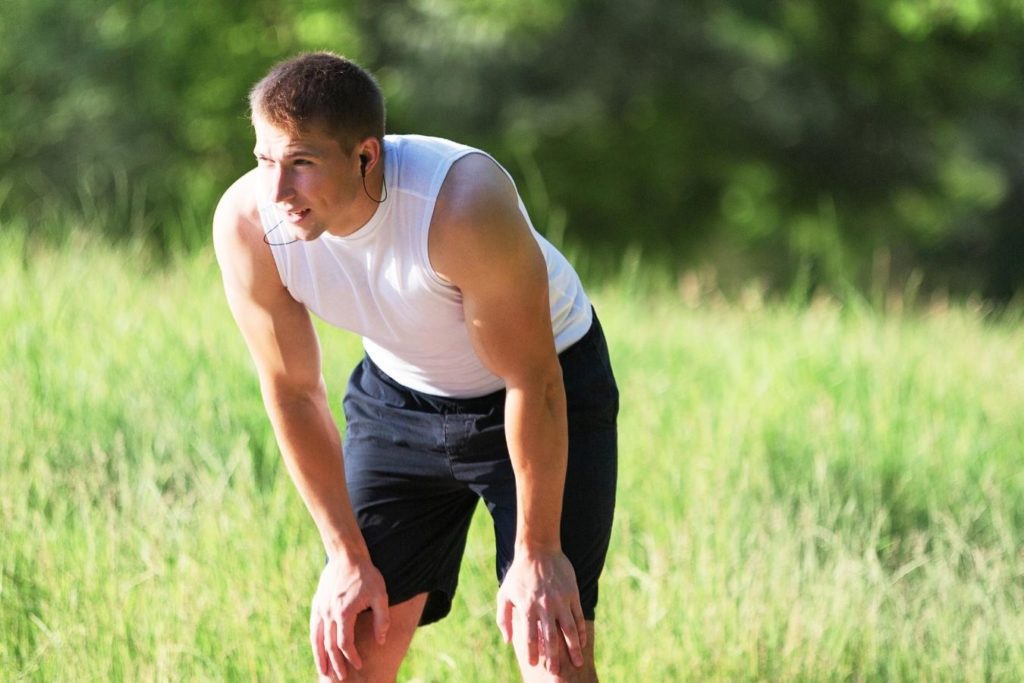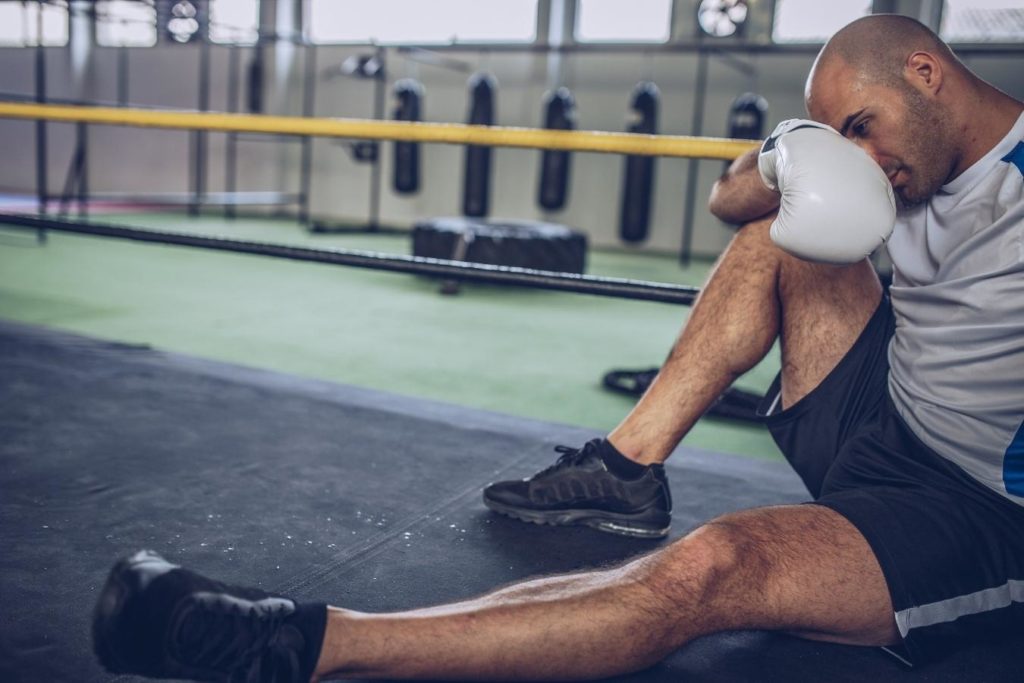There is nothing worse than finishing a round, feeling so gassed you can barely drink water, then having to come out again to fight or roll. But there are a few different strategies to enhance your recovery between these rounds.
Developing the aerobic energy system will help you recover faster between rounds as it plays the largest role in facilitating recovery. Further, positioning yourself in a bent-over position allows you to inhale more air than standing or sitting upright.
If you want to know the how and why behind recovering faster between rounds, then read on!
Bend Over With Your Hands Or Elbows On Knees

Your high school coach was wrong. Standing in-between conditioning drills with your hands on your head to show your opponents you’re not tired was likely making you more tired.
A 2016 study on high school track athletes found resting bent over with their hands on their knees resulted in more air being inhaled, and therefore, more oxygen compared to standing with their arms at their sides or overhead after an intense conditioning session [1].
This has been replicated recently where Division II soccer players were able to recover their heart rate faster 60 seconds after intense conditioning with their hands on their knees compared to on their heads [2].
Why is this the case?
Being bent over puts you in spinal flexion rather than extension. This spinal flexion is what maximizes the surface area of what is known as the diaphragmatic zone of apposition [2].

How to Dominate Every Fight with Raw, Explosive Power No One Can Match
Discover the underground blueprint that has quietly turned MMA hopefuls into legends, using nothing but sheer, brute force and bulletproof conditioning techniques.
In this position, the diaphragm is placed in a dome shape and proper diaphragmatic breathing can happen without other muscles being involved.
When recovering between rounds, it may be more beneficial to rest bent over, with your elbows on your knees when sitting compared to sitting upright and leaning back.
This isn’t always possible. Especially if you have the cutman patching you up. But it is definitely a conversation worth having with your coach to enhance your recovery between rounds.
Develop Your Aerobic Energy System
Many combat athletes don’t spend enough time focusing on aerobic energy system development and instead opting for high-intensity interval training as it is quick and leaves you out of breath very quickly.
However, very low intensities are needed to elicit favorable aerobic adaptations that will help you recover faster between rounds.
Firstly, we know that the aerobic energy system is the most important energy system for improving recovery between high-intensity efforts, rounds, and fights [3]. That means, the better developed your aerobic energy system is, the faster you will recover between rounds.
Secondly, a well-developed aerobic energy system is what keeps blood lactate levels lower at higher intensities. Why is this important?
The longer we can operate using mainly aerobic processes, the longer we can fight without fatigue. While lactate (or lactic acid) isn’t the cause of muscle fatigue and gassing out, the by-products that are formed in conjunction with lactate are what contribute to gassing out.
These by-products, mainly hydrogen ions (H+) acidify the muscle which reduces the muscle’s ability to contract. Therefore, resulting in fatigue. Blood lactate only starts to skyrocket when the intensity of exercise is very high or the aerobic energy system isn’t developed enough to clear this lactate.
The aerobic energy system works like a vacuum. It uses this lactate and converts it to useable energy, not allowing it to accumulate.
As you develop the aerobic energy system, you will be able to produce more power and lower heart rates, and fight at higher heart rates before lactate accumulates too much and the anaerobic processes take over.
Overall, you won’t need to dip into your anaerobic energy reserves and can operate under your anaerobic threshold predominantly with aerobic processes all leading to not having to recover so much between rounds.
Improve Your Heart Rate Recovery

A faster heart rate recovery (HRR) is associated with better aerobic development and when HRR is prolonged, it results in impaired performance and a greater chance of fatigue [2].
The first step to improving HRR is developing your aerobic energy system as that is what will speed the recovery after high-intensity efforts.
The second step is to practice getting your heart rate as low as possible after every effort you perform in training. For example, when sparring, during the rest between rounds, focus on your nasal breathing in the bent-over position.
If you have your heart rate monitor on, you can visually watch your heart rate drop and try different methods and see which results in a faster recovery.
References
1. Skaggs, J. R., LaGuardia, E. R., Sini, M., Wren, T. A., Woon, R. P., & Skaggs, D. L. (2016). The effect of arm and body position on respiratory ventilation in high school athletes: A pilot study. International Journal of Athletic Therapy and Training, 21(1), 30-34.
2. Michaelson, J. V., Brilla, L. R., Suprak, D. N., McLaughlin, W. L., & Dahlquist, D. T. (2019). Effects of two different recovery postures during high-intensity interval training. Translational Journal of the American College of Sports Medicine, 4(4), 23-27.
3. Tomlin, D. L., & Wenger, H. A. (2001). The relationship between aerobic fitness and recovery from high intensity intermittent exercise. Sports Medicine, 31(1), 1-11.

